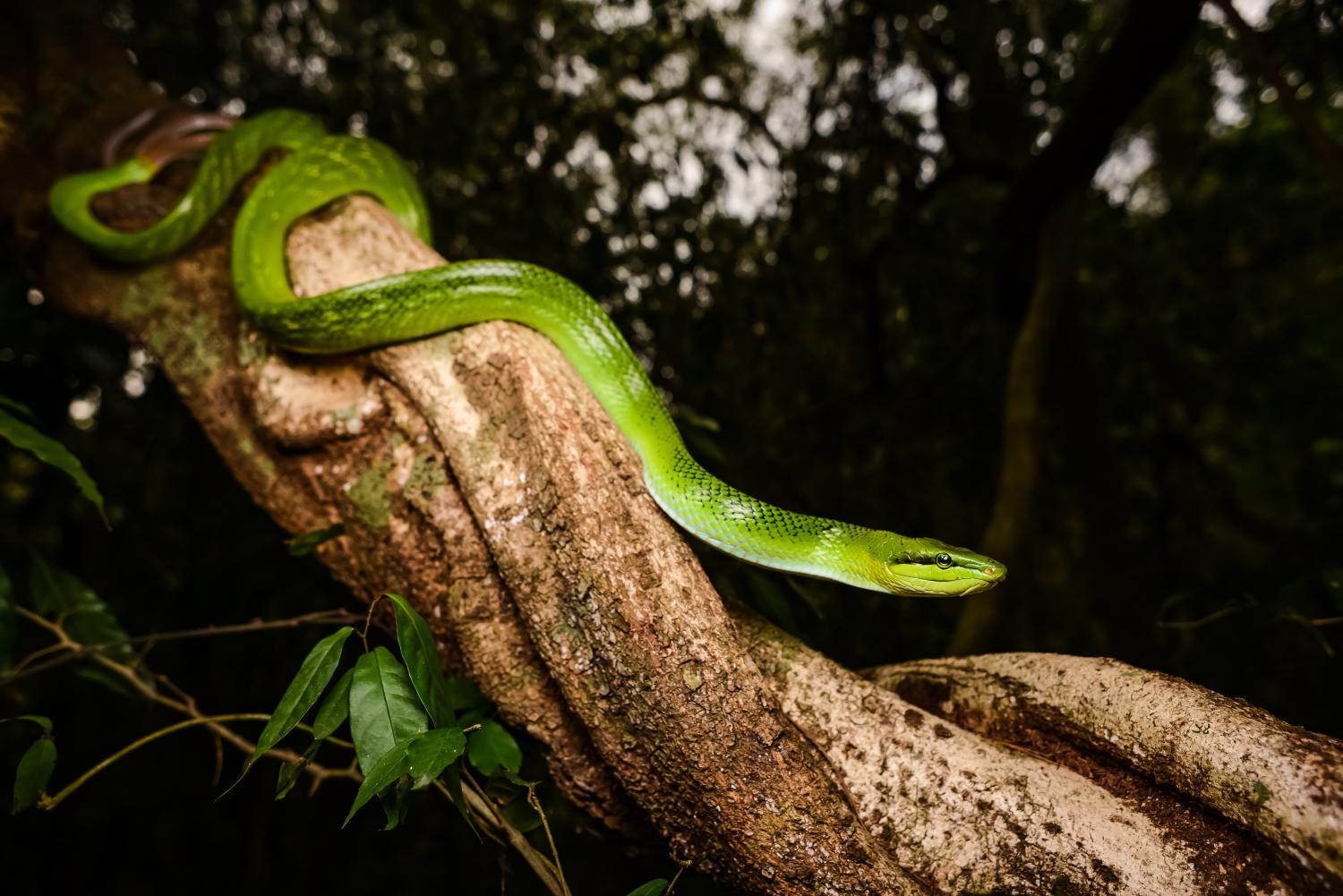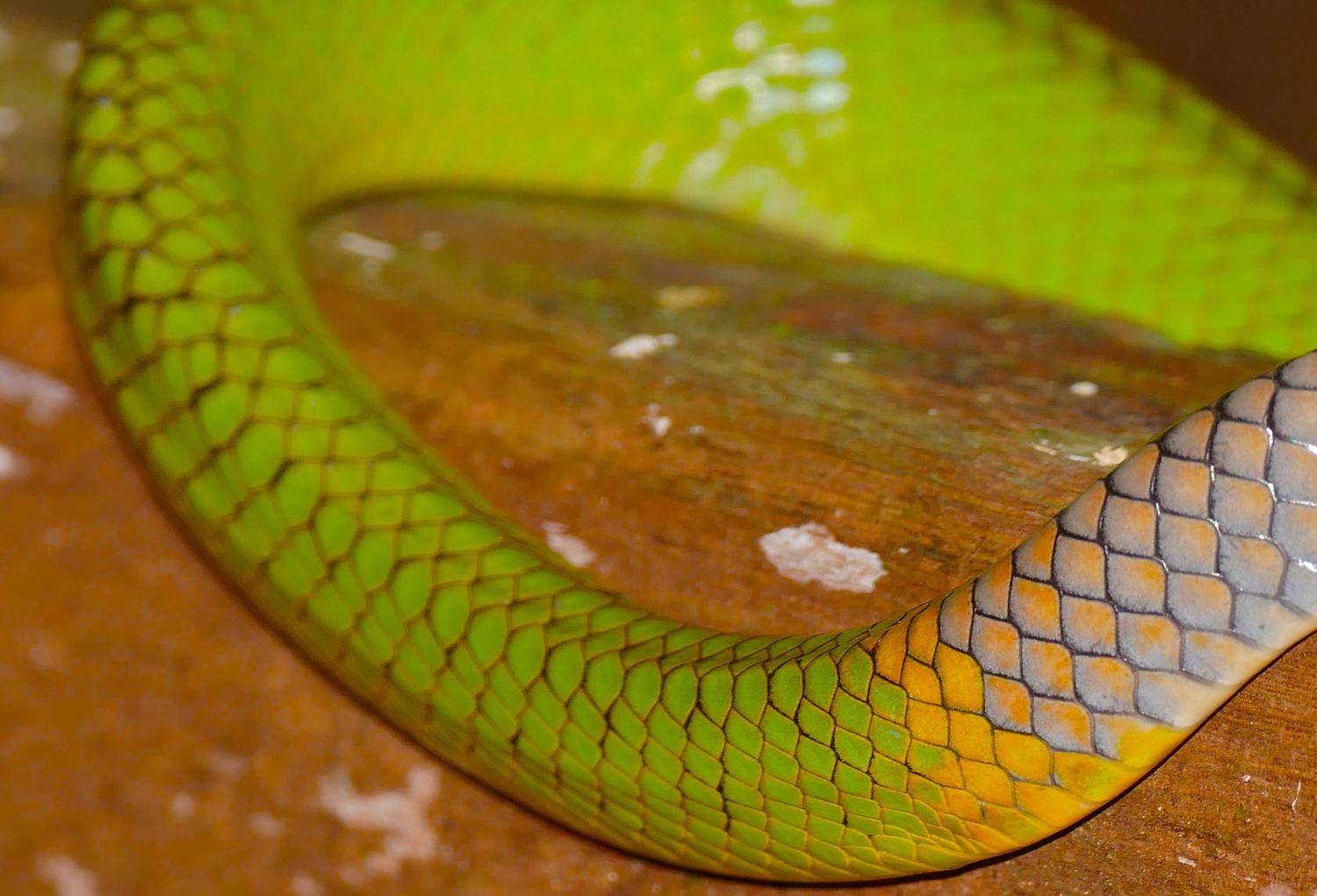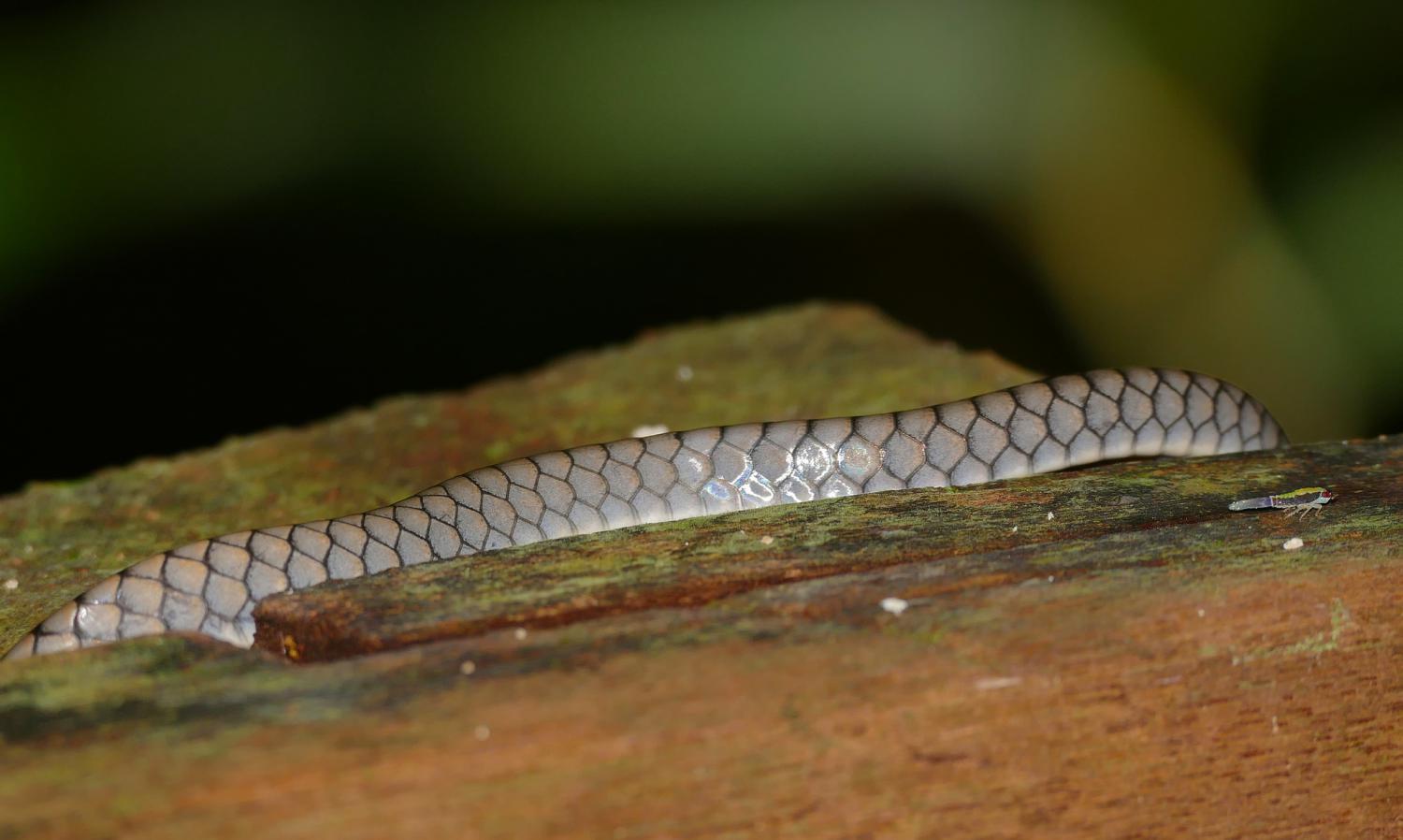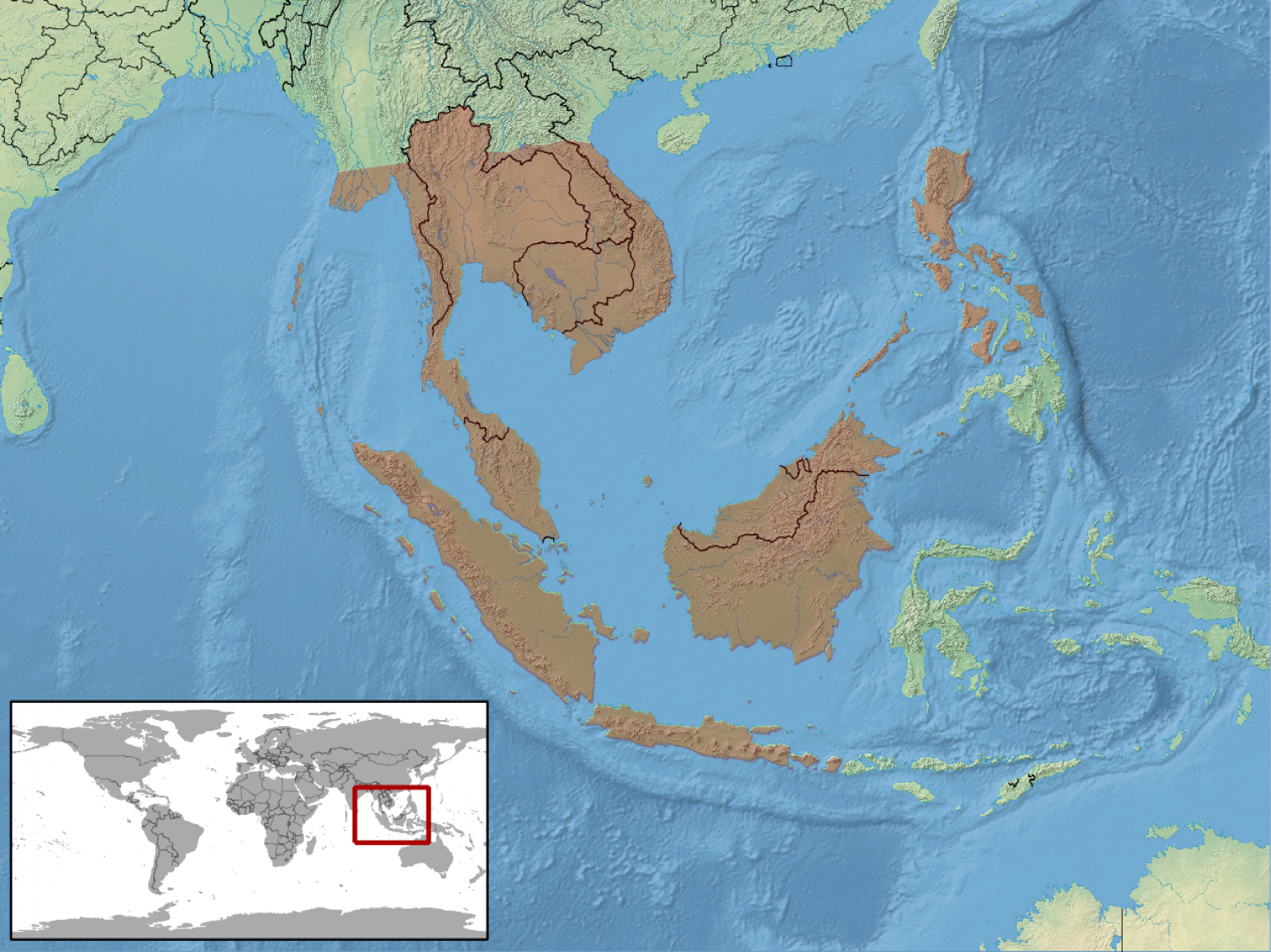Species of Thailand
Red-tailed tree snake
Gonyosoma oxycephalum
(Heinrich Boie, 1827)
In Thai: งูเขียวกาบหมาก
Gonyosoma oxycephalum, known commonly as the arboreal ratsnake, the red-tailed green rat snake, and the red-tailed racer, is a species of snake in the family Colubridae. The species is endemic to Southeast Asia.
It was first described by Friedrich Boie in 1827.
Description
G. oxycephalum is a robust powerful snake, with wide smooth scales on its belly that are ideal for climbing trees and across branches. It has smaller, smooth scales on its back, which is usually bright green or light green and may have a black net-like pattern. A gray-colored morph with a yellow head exists in Panay, in the Philippines.
As some of its common names indicate, the snake has a green body with a red tail, but is usually brown. It also has a dark line horizontally across the eye. On the sides of its black tongue there may be brown and blue colour. The top of the head may be dark green, yellow-green, or yellow in colour.
The female can reach a length of up to 2.4 m (almost 8 feet), while the male is generally a little bit smaller but brighter in coloration.
Longevity
The average life span of G. oxycephalum in captivity is 20 years.
Reproduction
G. oxycephalum reaches sexually maturity at 4 years of age, and its eggs have a hatching time from 13 to 16 weeks. The female lays on average between 3 and 8 eggs usually between September and January and the hatchlings are about 45 cm (18 inches) long.
Behavior
The red-tailed green ratsnake lives and spends its life in the trees and in cavities of trees. It seldom descends to the ground. When the snake is stressed, it may inflate a bag of air in its neck, making it appear larger in size.
In captivity, it has quite the "attitude" and may strike at or bite an unwary handler. Its temperament can be unpredictable and may change from time to time but an individual may become tame through proper handling.
Diet
G. oxycephalum feeds almost exclusively on birds, bird eggs, lizards, and bats. It catches them in mid-air while hanging amongst branches. In captivity, it can be trained to feed on rodents such as mice and rats.
Distribution
G. oxycephalumm is found in the following countries:
- Indonesia (Bangka, Belitung, Java, Kalimantan/Borneo, Karimata, Legundi, Lombok, Mentawai islands, Natuna islands, Nias, Panaitan, Riau archipelago, Sebuku, Sumatra, Tambelan archipelago),
- Malaysia (Malaya and East Malaysia, Pulau Tioman ?),
- Singapore Island, Penang Island,
- India (Andaman Islands),
- Myanmar,
- Thailand (incl. Phuket), Cambodia, Laos, Vietnam,
- Philippine Islands (Balabac, Bohol, Catanduanes, Lubang, Luzon, Negros, Palawan, Sulu Archipelago, Panay).
The Type locality is Indonesia: Java (F. Boie, 1827).
Population
As of 2015, the Red-tailed Green Ratsnake was categorized as "Least Concern" by the IUCN due to its relatively healthy population estimated at 15, 000-20, 000 individuals across its range. However, recent data as of 2022 indicates a decline in its numbers, with an estimated population of around 10, 000-15, 000. Despite this decline, it still retains its "Least Concern" status.
This article uses material from Wikipedia released under the Creative Commons Attribution-Share-Alike Licence 3.0. Eventual photos shown in this page may or may not be from Wikipedia, please see the license details for photos in photo by-lines.
Scientific classification
- Kingdom
- Animalia
- Phylum
- Chordata
- Class
- Reptilia
- Order
- Squamata
- Suborder
- Serpentes
- Family
- Colubridae
- Genus
- Gonyosoma
- Species
- Gonyosoma oxycephalum
Common names
- German:
- Spitzkopfnatter
- Rotschwanznatter
- English:
- Red-tailed tree snake
- Red-tailed racer
- Red-tailed green ratsnake
- Thai: งูเขียวกาบหมาก
Conservation status

Least Concern (IUCN3.1)
Photos
Please help us review our species pages if wrong photos are used or any other details in the page is wrong. We can be reached via our contact us page.
Range Map
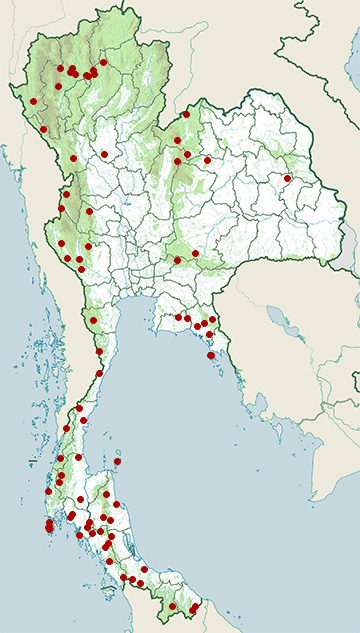
- Bang Lang National Park
- Chae Son National Park
- Chaloem Rattanakosin National Park
- Chana District, Songkhla
- Chiang Khan District, Loei
- Chulabhorn District, Nakhon Si Thammarat
- Doi Inthanon National Park
- Doi Suthep - Pui National Park
- Erawan National Park
- Huai Kha Khaeng Wildlife Sanctuary
- Huai Yang Waterfall National Park
- Huai Yot District, Trang
- Kaeng Krachan National Park
- Kapoe District, Ranong
- Kathu District, Phuket
- Khao Chamao - Khao Wong National Park
- Khao Chong
- Khao Khitchakut National Park
- Khao Nam Khang National Park
- Khao Phanom Bencha National Park
- Khao Phra - Bang Khram Wildlife Sanctuary
- Khao Sok National Park
- Khao Yai National Park
- Khlong Saeng Wildlife Sanctuary
- Khlung District, Chanthaburi
- Ko Chang District, Trat
- Ko Chang National Park
- Ko Lanta District, Krabi
- Ko Samui District, Surat Thani
- Kra Buri District, Ranong
- Kui Buri National Park
- Lam Thap District, Krabi
- Mae On District, Chiang Mai
- Mae Rim District, Chiang Mai
- Mae Sariang District, Mae Hong Son
- Mae Takhrai National Park
- Mueang Chiang Mai District, Chiang Mai
- Mueang Chumphon District, Chumphon
- Mueang Krabi District, Krabi
- Mueang Nakhon Si Thammarat District, Nakhon Si Thammarat
- Mueang Pan District, Lampang
- Mueang Phuket District, Phuket
- Nam Nao National Park
- Nong Phok District, Roi Et
- Nopphitam District, Nakhon Si Thammarat
- Phrasaeng District, Surat Thani
- Phu Kradueng National Park
- Phu Luang Wildlife Sanctuary
- Phu Wiang National Park
- Phuket Province
- Pong Nam Ron District, Chanthaburi
- Ramkhamhaeng National Park
- Sadao District, Songkhla
- Sai Yok District, Kanchanaburi
- Sai Yok National Park
- Sakaerat Environmental Research Station
- Samoeng District, Chiang Mai
- Si Banphot District, Phatthalung
- Su-ngai Kolok District, Narathiwat
- Taksin Maharat National Park
- Takua Pa District, Phang Nga
- Tha Chana District, Surat Thani
- Tha Mai District, Chanthaburi
- Tha Sae District, Chumphon
- Tha Song Yang District, Tak
- Thalang District, Phuket
- Thale Ban National Park
- Thong Pha Phum District, Kanchanaburi
- Thung Song District, Nakhon Si Thammarat
- Thung Wa District, Satun
- Thung Yai Naresuan Wildlife Sanctuary
- Umphang Wildlife Sanctuary
- Waeng District, Narathiwat
- Wang Chan District, Rayong
- Wang Nuea District, Lampang
- Wang Wiset District, Trang
- Yan Ta Khao District, Trang

